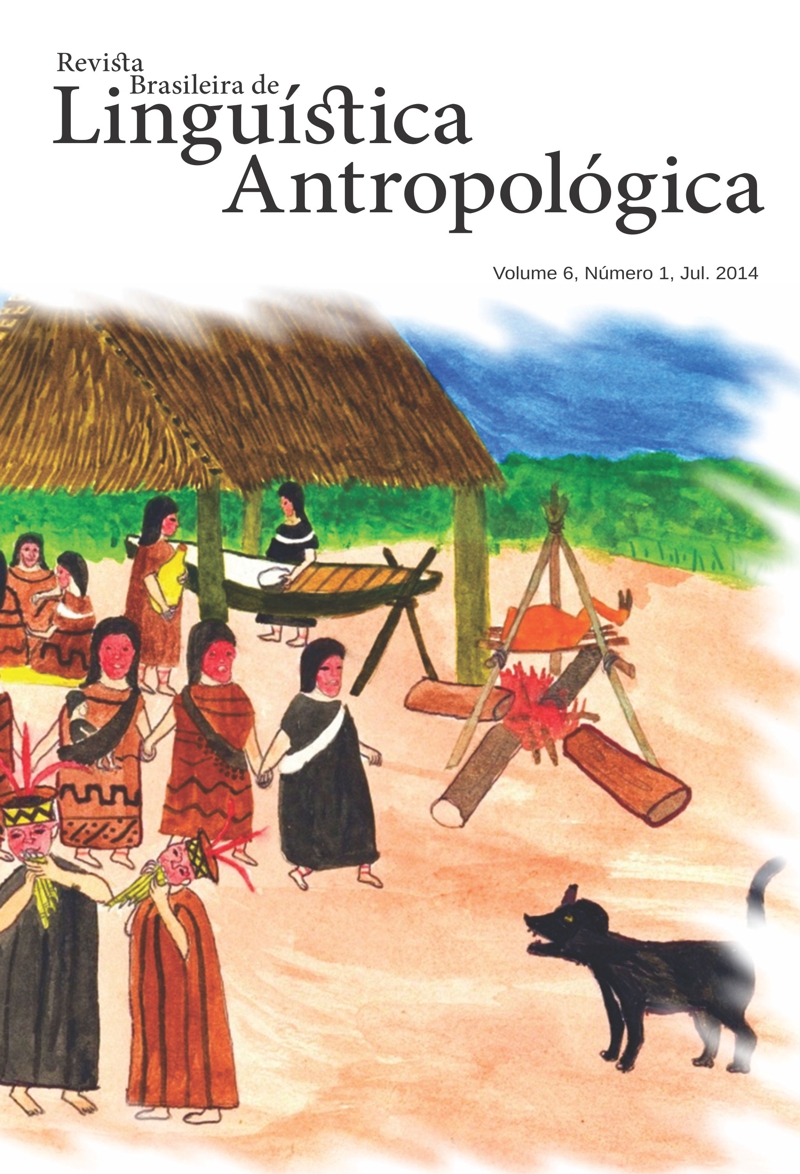Indexação verbo-sujeito nas línguas Tukáno: categorização dos referentes nominais e sua codificação nos verbos
DOI:
https://doi.org/10.26512/rbla.v6i1.21065Palavras-chave:
Classificação nominal. Número. Pessoa. Indexação. Língua Tukáno.Resumo
Descrevemos três sistemas de classificação nominal presentes em três línguas indígenas brasileiras ”“ Mehináku (família Aruák), Nahukwá-Kalapálo (família Karíb), e Suruí (falada pelos Paitér éy) (família Mondé, tronco Tupí). Com exceção do sistema de classificadores da língua Mehináku, do qual Mori (2005, 2007, 2012) descreveu alguns aspectos, os outros dois sistemas são aqui descritos pela primeira vez e juntos evidenciam singularidades de sistemas de classificação nominal ainda não considerados em estudos descritivos, históricos ou tipológicos sobre línguas Tupí e Karíb.Downloads
Referências
Aikhenvald, Alexandra Y. Classifiers. A typology of noun categorization devices. Oxford: Oxford University Press, 2000.
Ariel, Mira. 1990. Accessing Noun Phrase Antecedents. London: Croom Helm.
Barnes, Janet. 1984. Evidentials in the Tuyuca verb. IJAL 50.255-271.
Barnes, Janet & Terrell Malone. 2000. El Tuyuca. In María Stella González de Pérez & María Luisa Rodríguez Montes (eds.), Lenguas indígenas de Colombia: Una vision descriptive. 437-452. Santafé d
Chacon, Thiago Costa. 2014. A revised proposal of proto-tukanoan consonants and tukanoan family classification. IJAL, vol. 80, no. 3, pp. 275”“322.
Chacon, Thiago Costa. 2012. The phonology and morphology of Kubeo: The documentation, theory and description of an Amazonian language. Ph.D. dissertation, University of Hawai’i.
Chacon, Thiago Costa. 2007. O sistema de classificação nominal do Tukáno. Revista de Estudos e Pesquisa. IV. Brasília: Funai.
Corbett, Greville. 2000. Number. Cambridge: Cambridge University Press.
Corbett, Greville. 2006. Agreement. Cambridge: Cambridge University Press.
Croft, W. 2013. Agreement as anaphora, anaphora as coreference. Languages across boundaries: studies in memory of Anna Siewierska, ed. Dik Bakker and Martin Haspelmath, 107-29. Berlin: De Gruyter Mouton.
Cook, Dorothy M. and Linda L. Criswell. 1993. El idioma koreguaje (tucano occidental). Bogotá: Asociación Instituto Lingüístico de Verano.
Gomez-Imbert, Elsa. 1982. De la forme et du sens dans la classification nominale en tatuyo (langue Tukano Orientale d’Amazonie Colombienne), Doctorat de 3e cycle. Paris: U. Paris-Sorbonne (=TDM 19, Editions ORSTOM, 1986), downloadable in www.ird.fr.
Gomez-Imbert, Elsa. 2007. Nominal classification in Tukanoan languages. In W. Leo Wetzels (ed.) Language Endangerment and Endangered Languages: Linguistic and Anthropological Studies with Special Emphasis on the Languages and Cultures of the Andean-Amazonian Border Area. Indigenous Languages of Latin America series (ILLA). Publications of the Research School of Asian, African and Amerindian Studies (CNWS). The Netherlands: Leiden University.
Gomez-Imbert, Elsa. 2004. Fonología de dos idiomas Tukano orientales. Amerindia. Vol. 29. Paris: CELIA.
Gomez-Imbert, Elsa. 2000. Como si tú y el agua fuesen una misma persona gramatical. Hein van der Voort & Simon van de Kerke (eds.), Indigenous Languages of Lowland South America [Indigenous Languages of Latin America, 1], p. 129-148. Leiden: Research School of Asian, African, and Amerindian Studies (CNWS).
Simon van de Kerke. 2011. La famille tukano. Dictionnaire des langues du monde, pp. 1454-60. Paris: Presses Universitaires de France.
Greenberg, Joseph. 1963 [1966]. Some Universals of Grammar with particular reference to the Order of Elements. Universals of language, ed. Joseph H.
Greenberg. 2nd edition. Cambridge, Massachusetts: MIT.
Grinevald, Colette. 2000. A morphosyntactic typology of classifiers, in: Gunter Senft (ed.), Systems of nominal classification. pp. 50-92. Cambridge: Cambridge University Press, 2000.
Grinevald, Colette & Seifart, Frank. 2004. Noun Classes in African and Amazonian languages: Towards a comparison. Linguistic Typology 8.243-285.
Haspelmath, M. 2013. Argument indexing: a conceptual framework for the syntax of bound person forms. In: Bakker, Dik & Haspelmath, Martin (eds.) 2013. Languages across boundaries: Studies in memory of Anna Siewierska, 197-226. Berlin: De Gruyter Mouton.
Malone, Terrell. 1988. The origin and development of Tuyuca evidentials. IJAL 54/2: 119-140.
Mason, J. A. 1950. The languages of South American Indians. Bureau of American Ethnology Bulletin 143:157”“317.
Miller, Marion. 1999. Desano grammar: Studies in the languages of Colombia 6. Summer Institute of Linguistics and the University of Texas at Arlington Publications in Linguistics, 132. Dallas: Summer Institute of Linguistics and the University of Texas at Arlington. xi.
Morse, Nancy L. & Michael B. Maxwell. 1999a. Cubeo Grammar. (Studies in the Languages of Colombia, 5; SIL Publications in Linguistics, 130.) Arlington: SIL and University of Texas Arlington Press.
Ramirez, Henri. 1997. A fala Tukáno dos Ye’pa Masa: Gramática. Tomo I. 1 ed. Manaus: CEDEM.
Senft, Gunter (ed.). Systems of nominal classification. Cambridge: Cambridge University Press, 2000.
Siewierska, Anna. 2004. Person. Cambridge: CUP.
Silva, Wilson. 2012. A Reference grammar of Desano. PhD dissertation. University of Utah.
Skilton, Amalia. 2013. A new proposal of Western Tukanoan consonants and internal classification. Senior Thesis Essay. Yale University.
Stenzel, Kristine. 2013. A Reference Grammar of Kotiria (Wanano). Lincoln: University of Nebraska Press.
Strom, Clay. 1992. Retuarã Syntax: Studies in the Language of Colombia 3. Arlington: Summer Institute of Linguistics/University of Texas, 1992.
Wheeler, Alva. 1987. El pueblo siona del río Putumayo, Colombia. Vol. 1: Etnología, gramática, textos. Bogotá: Instituto Linguistico de Verano.
Downloads
Publicado
Como Citar
Edição
Seção
Licença

Este trabalho está licenciado sob uma licença Creative Commons Attribution 4.0 International License.
Autores que publicam na RBLA concordam com os seguintes termos:
a) Autores mantêm os direitos autorais e concedem à revista o direito de primeira publicação, sendo o trabalho simultaneamente licenciado sob a Creative Commons Attribution License, o que permite o compartilhamento do trabalho com reconhecimento da autoria do trabalho e publicação inicial nesta revista.
b) Autores têm autorização para assumir contratos adicionais separadamente, para distribuição não exclusiva da versão do trabalho publicada nesta revista (ex.: publicar em repositório institucional ou como capítulo de livro), com reconhecimento de autoria e publicação inicial nesta revista.
c) Autores têm permissão e são estimulados a divulgar seu trabalho online (ex.: em repositórios institucionais ou na sua página pessoal) a qualquer ponto antes ou durante o processo editorial, já que isso pode gerar alterações produtivas, bem como aumentar o impacto e a citação do trabalho publicado.







